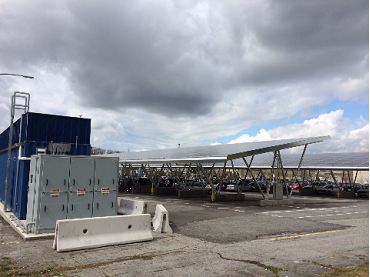Energy OASIS (Open Access to Sustainable Intermittent Sources) Project
Lead Proponent: British Columbia Institute of Technology, Smart Microgrid Applied Research Team (SMART).
Location: Burnaby, British Columbia
CEF Contribution: $ 4.4 M
Project Total: $ 9.1 M
Project Background:

Energy OASIS, BCIT
Text Version
Energy OASIS: 250 kW solar photovoltaic (PV) panels mounted on 2 parking canopy structures in Lot 7 of BCIT's Burnaby Campus, integrated with two level-3 (DC Fast Charge) and two level-2 electric vehicle chargers, and a 500-kWh lithium-ion battery energy storage system.
In British Columbia, where the majority of electrical power is generated from hydro-electric systems, motor vehicle emissions constitute the largest portion of the province’s emissions. One way to reduce greenhouse gas (GHG) emissions is to electrify the transportation system. The province is at the forefront in Canada, when it comes to market interest for electric vehicles and related infrastructure. Advances are underway in vehicle battery technology and charging infrastructure, including the installation of “fast charging” stations that enable electric vehicles to be charged in minutes (rather than hours). However, clusters of “fast charging” stations could potentially cause unplanned stress on electric grid system, given the high instantaneous demand.
For that reason, the British Columbia Institute of Technology (BCIT) proposed a project to demonstrate solutions that could be employed to help mitigate the impact of fast-charging on the grid. The “Energy OASIS (Open Access to Sustainable Intermittent Sources) Project” was awarded $4.2M from the Clean Energy Fund (CEF) to integrate photovoltaic panels and Li-Ion storage for a Level-3 electric vehicle charge station with BCIT’s Smart Microgrid system.
Results:
A joint working group between BCIT and BC Hydro took on the task of defining the OASIS initial blueprint. The project officially kicked-off in June 2012 with a multi-stakeholder partnership between BC Hydro, Panasonic Eco Solutions Canada (PESCA), Siemens Canada, Schneider Electric, and car2go. The OASIS system components included: a 500 kWh Li-ion Battery Energy Storage System (BESS), a 250 kW solar photovoltaic (PV) system, 2 DC Fast Charge (DCFC) stations for electric vehicles (EV), and a highly sophisticated energy management system (EMS). The EMS would perform energy planning, as well as energy balancing between solar PV system generation, EV charging loads, battery energy storage system, and local power distribution grid.
After extensive on-site testing, including component commissioning, system integration, system functional testing and use-case testing, the system came online in March 2014. In the months following, component problems and deficiencies had to be addressed. Therefore, the operational percentages were low with the system in operation less than 20% of the time. An extension to the system commissioning period was required to resolve the operational problems that had arisen. These included the addition of an acoustic enclosure to mask equipment noise and modification of faulty control logic.
By the end of November 2015, OASIS was operating continuously aside from regular maintenance and minor downtimes, which boosted its availability to approximately 85%. In the next nine months, the PV system generated 135MWh of energy, a 72% increase over the same period in the previous year. The total solar generation of OASIS since it came online is 260MWh. The project was successful at demonstrating the use of a solar PV system to generate, store and support EV charging stations using a BESS.
Up to the end of August 2016, the 2 DC fast chargers at Energy OASIS were used over 1700 times, consuming nearly 15MWh of energy. The vehicle models which used the chargers included the Nissan Leaf, Kia Soul EV, Mitsubishi i-Miev and Tesla Model S. An average charging session was approximately 20 minutes long and used 8.3kWh of energy. In a 12 month period starting in September 2015, the system also supplied 3MWh of energy in over 700 charging sessions to EV via a bank of six Level-2 EV Charging Stations. Although these chargers charged at a slower rate than the fast chargers, they serviced a wider range of EV models as well as plug-in hybrids which extended the aforementioned list with Chevrolet Volt, BMW i3, Smart Fortwo electric drive and Audi A3 e-tron.
Benefits to Canada:
The project showcases the integration of renewables, storage, electric vehicle charging loads, and intelligent controls in a fully islandable and smart microgrid environment. Replication across country would support the growth of EVs and contribute to the reduction of GHG emissions in Canada.
Next steps:
Several observations were made with the data collected thus far and will be further tested. For example, the BESS was capable of storing energy from both the grid and PV installation and discharging it back to the grid or to the EV chargers but with an unexpected round trip loss. Longer term testing is required to confirm or disprove the observed loss. Additionally, the valuable assets of OASIS system are being leveraged for other Smart Grid research projects involving municipal electric vehicle charging infrastructure, energy management software development for remote communities and campus power peak shaving experimentations.
Page details
- Date modified: